| ALL ABOUT PICTURE FRAME FILLETS |
 |
|
Fillets are decorative elements used in picture framing to a number of different ends. They add interest and detail to any picture framing project, and are quite easy to assemble and install.
This article discusses the use and purpose of fillets in picture framing.
|
SUMMARY
| WHAT IS IT? |
HOW TO INSTALL |
WHY TO USE |
| Fillets are essentially thin picture frame mouldings that can be used between the frame and the art, or the mat and the art, for added decor. |
Fillets are cut to size and adhered to the back of the window mat or under the picture frame lip. |
Fillets can add a cohesive element, create visual space, or add some extra detail to a plain frame. |
|
| WHAT IS A FILLET?
|
 |
|
Fillets - also spelled "filet", or called a slip - look like very thin picture frames. They are used as additional decoration at the inside edge of frames or window mats, to draw attention to the artwork within. They are similar to linen liners but can be used both with and without glazing.
Traditionally, fillets were constructed from solid wood just like frames, and were usually covered in gold leaf. Today, fillets may be soft or hard wood, plastic, or metal, and come in as many different finishes and designs as the picture frame itself.
Fillets sit on top of the artwork, as opposed to providing a lip for the art to sit in, like a picture frame. Instead, the "rabbet" section of the fillet is above the lip, so the mat or picture frame can sit on top the fillet.
Depending on the company supplying them, fillets may be sold separately, in long lengths like frame moulding, or cut and already attached to the window mat. The latter may be available in standard or custom sizes, depending on the provider.
|
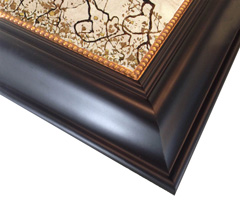
Black frame with gold fillet
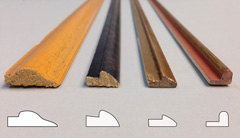
Different fillet profiles
|
| HOW TO INSTALL FILLETS
|
 |
- First, the picture frame is assembled, or window mat is cut, to size. Don't forget the fillet will cover another 1/4" to 1" of the artwork, so the frame or mat opening should be made larger as necessary.
- Double-sided tape is applied to the back inside edge of the window mat, or to the lip of the picture frame.
- When applying a fillet to a window mat, the mat opening should be straight-cut, not bevelled. A bevel will weaken the edge on which the fillet is attached, and is unnecessary for the display.
- The fillet lengths are cut down to be slightly larger than the lengths of the mat or frame opening. They will be carefully trimmed to ensure a perfect fit within the opening.
- The protective cover on the double-sided tape is removed, and the correct fillet attached, one side at a time. The fillets should be attached moving around the opening - short side, long side, short side, long side.
- Once the fillets are in place, build up the back of the window mat using acid-free foam board, or more matboard to lie flush with the back of the fillet. This will reinforce the mat and keep it from bending.
- Finally, place acid-free tape across the back of the mat, covering the entire backside of the fillet. This is essential for wood fillets to keep the acids in the wood from damaging the artwork, but it's advisable for any fillet material, to reinforce the double-sided tape. Alternately, a second window mat can be placed over the fillets to completely cover the first mat and the fillets.
- Don't forget to select a picture frame with a rabbet deep enough to hold this new, thick mat!
For a visual version of these instructions, check out this great how-to for placing fillets onto a window mat.
|
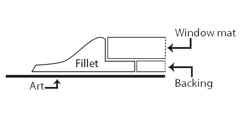
Fillet attach to window mat

Fillet attached to picture frame
|
| WHAT A FILLET CAN DO FOR YOUR ARTWORK
|
 |
|
Fillets can serve a number of purposes in a framed artwork, though they are not a required part.
- The same fillet moulding can be used within the mat and the frame to create a harmonious display.
- By using a contrasting color (such as the silver on black, above), the fillet can add definition to the mat or frame.
- A fillet that matches the frame can make the frame appear wider.
- A plain fillet inside a patterned frame creates visual relief (similar to the purpose of a window mat).
- Multiple fillets can be used together: two matching to create a wide fillet, or one plain and one ornate for contrast.
- Inverse fillets (mitering the moulding so the lip is on the inside instead of the outside) can be used as frames for small pieces of artwork that do not need glass. The double-sided tape is placed on the back of the artwork, and the fillets are attached as they would be to a mat.
This useful YouTube video shows different ways fillets can be used.
|
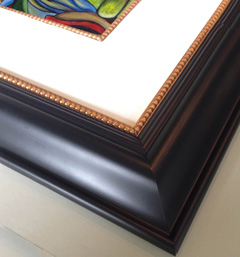
Double, matching fillet creates harmony across display
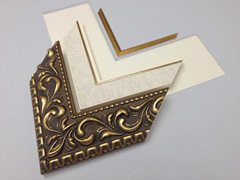
Corner samples: frame, liner, mat, fillet
|
|
Fillets are a great way to add style and prestige to any framed artwork.
If you have questions about any of our services or products, don't hesitate to contact us. Our knowledgeable staff is always happy to assist with answers, advice, or suggestions.
|
|
© 2002-2025 - KeenART Media Ltd.
|
|
| |
|
